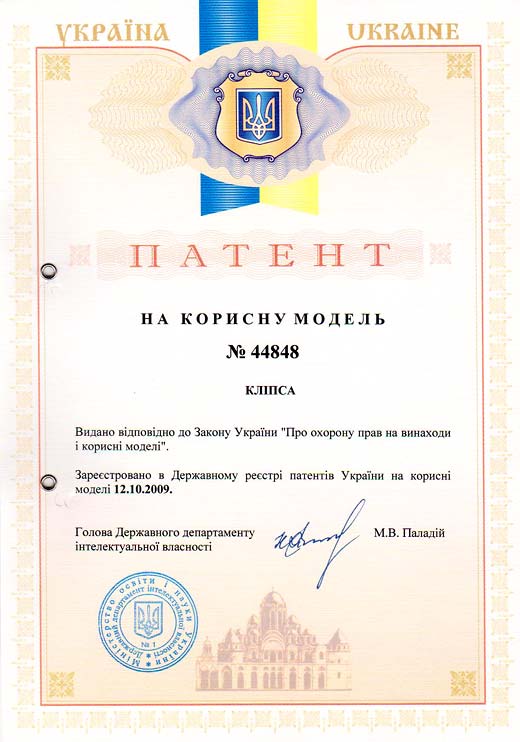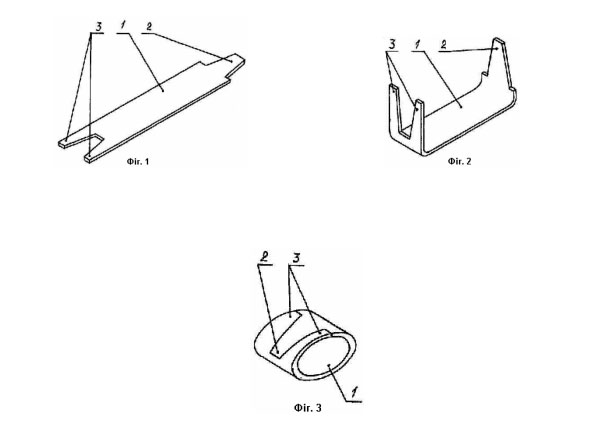Patent of Ukraine: №44848
Author: Tkachenko Yuriy Vladimirovich
IPC Section: E04H 17/00 – Fences, railings, fences
IPC Section: F41H 11/00 – fortification, defensive devices
Published: 12.10.2009, Bulletin №19 / 2009
The clip for attaching the barbed wire rings – the Patent of Ukraine №44848

The clip has a metal form, the ends of which in the original state smoothly (radially) are bent in the same direction by almost a right angle, and is characterized in that its form is made of a flat belt, and the ends of the form are in the form of whiskers. Moreover, one end of the form has a central mustache with the parties, which are expanded in the direction of the form and the other end has two extreme whiskers, which is adequate clearance between the shape and size of the central whisker at the opposite end of the form. When the clip has been bent into a ring, whiskers tightly joined without gaps and are arranged in one plane.
The utility model belongs to the metal production, namely, the production of barbed tape, barbed wire Egoza, which is used as a safety barrier and are designed to prevent unauthorized penetration of sensitive sites and can be used in the manufacture of protecting designs of barbed tape.
Known clip which has a form of metal wire of circular section, the ends of which in the original state smoothly (radially) are bent in the same direction by almost a right angle. Clips placed in the crimping tool with which it is folded into the ring [see the Prospect of the German company «Haubold». Clip GDH galvanized wire with a diameter of 1, 8 mm costing 45 euros per pack (10 thousand items)]. This known clip is closest in nature and effect, which is achieved and, therefore, is taken as a prototype.
The main drawback of the known clip is that it is made of thin metal wires, which reduces its functional properties. This disadvantage is explained as follows. The known clip is made of relatively thin wires – 1, 8 mm so that it was easy to bend. But such a thin wire provides a low rigidity, and therefore easy to unbend clip even with hand, so the load on the fence she willfully unbend. In addition, it is easy to straighten force: it is enough to catch anything, such as a screwdriver, for the end of the form, bend the ends of the clip and remove it from the enclosure. In addition, it is possible without significant effort bite, even ordinary household scissors. All this reduces the reliability of the safety barrier, which is constructed using known clips because of their low functional properties.
The basis of the utility model the task of enhancing the functional properties of the clip by changing its structure by giving the form along the edges of the mustache, tightly interconnected flexed clips.
This object is achieved in that the clip that has a metal form, the ends of which in the original state smoothly (radially bent in the same direction by almost a right angle, and is characterized in that its form is made of a flat tape, and the ends of the form are in the form whiskers, and one end of the form has a central whisker with sides that extend in the direction of the form and the other end has two extreme whisker gap between which is adequate to the shape and size of the central whisker at the opposite end of the form and, while bending the clip into the ring mustache tightly connected without gaps and are located in one plane.
Implementation of clips of thin metal strip eliminates the possibility of her snacking though household scissors, although metal shears as a bent into the ring clip cannot stick scissors (items barbed tape fence covered and clenched the ring, that is, there is no free space where you can insert the scissors) and the ends of the ring is quite thin so that you can grasp them with scissors. Execution ends of clips in the form of whiskers allows, after bending the clip into a ring form dense Keyhole compound without gaps between the sides of whiskers, and in the same plane, which eliminates the possibility of extension of all, since, due to the absence of gaps, there is no place to insert such as screwdrivers or a knife blade. The tape bent into a ring has sufficient rigidity and unbent spontaneously when the load on the fence.

Further essence of the utility model is explained in conjunction with illustrative material, showing the following:
- 1 – Scan clips that offers a schematic view;
- 2 – Clip proposed in the initial position, schematic view;
- 3 – Proposed in a bent clip (working) position, schematic view.
Asking clip contains the form of 1 of the metal strip. At one end of the form 1 is located a central whisker 2 with sides that extend in the direction of the form 1. The second end of the form 1 is two extreme whiskers 3, the gap between which corresponds to the shape and size of the central CCD 2 at the opposite end of the form 1. When bending the clip into a ring, whisker 2 enters the gap between the antennae 3 and tightly connected with them, i.e. without gaps, and all the whiskers 2 and 3 are located in the same plane without a gap between their sides. Thus, bent in a ring clip is a cylinder with no protrusions on its surface, that is transformed in a sufficiently rigid structure that is difficult to forcibly straightened, as for the ends of the cylinder difficult to capture something of the fact that the cylinder is made of a thin metal strip, and it is impossible to bend the whiskers, as they do not protrude beyond the surface of the cylinder and are in contact without gaps.
The technical advantages of the proposed technical solution, as compared with the prior art, include increasing the barrier properties due to the increased rigidity of fencing clips and the impossibility of its forced extension due to changes in its structure.
Social benefits from the use of the proposal compared with the prototype, obtained by increasing the reliability of protection by fencing sensitive sites.